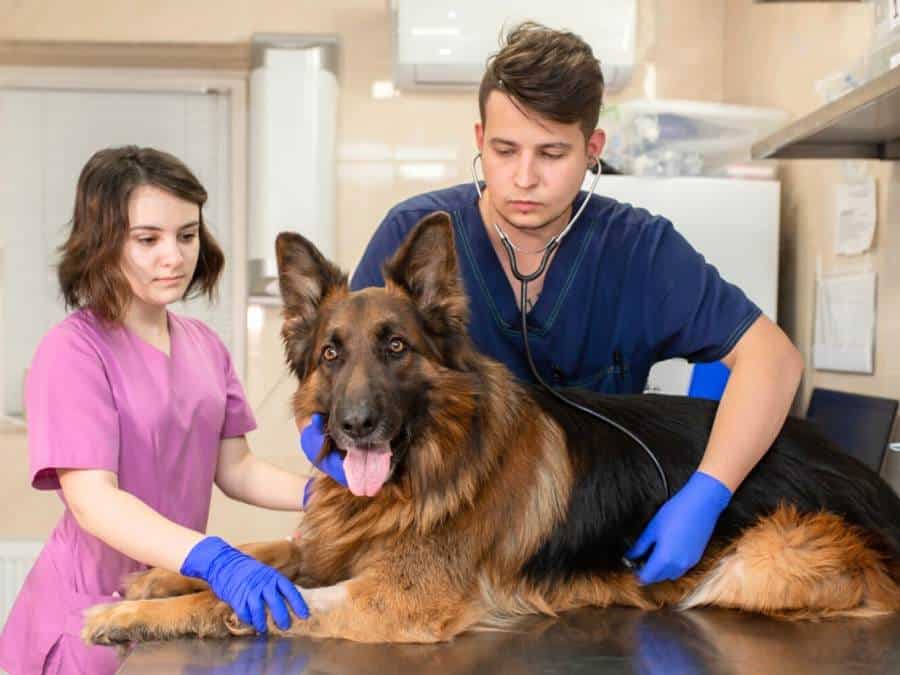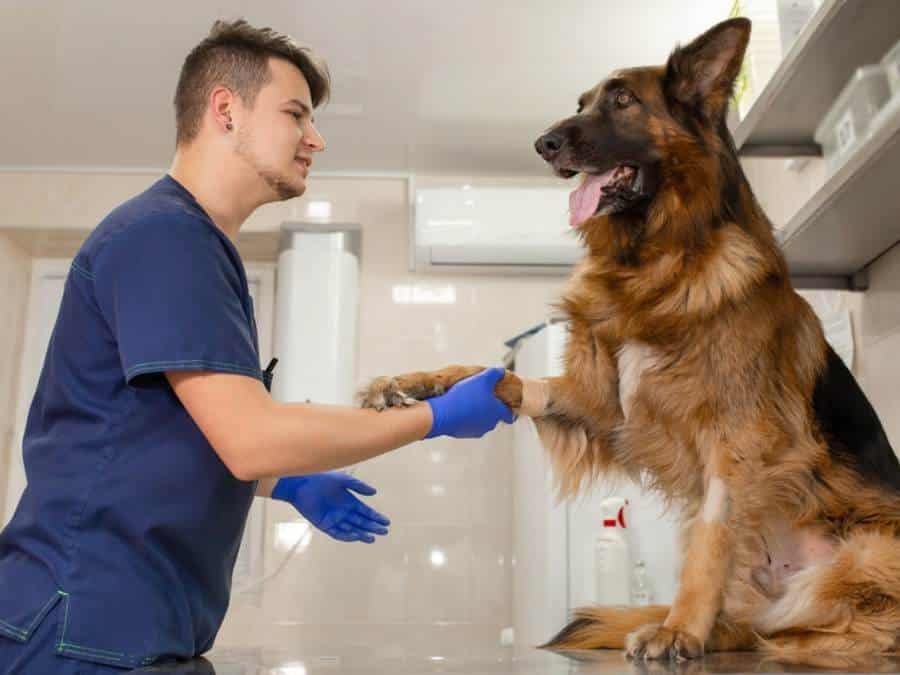Red eye in German Shepherds is a symptom that can point to a variety of conditions, ranging from minor irritations to serious health issues that require immediate attention.
Understanding what causes red eye, how to identify its associated symptoms, and knowing when to seek veterinary care are essential steps in ensuring your dog’s eyes remain as healthy and sparkling as their personalities.
In this comprehensive guide, we’ll explore everything you need to know about red eye in German Shepherds.
From the common causes and symptoms to detailed treatment options and preventative measures, I aim to equip you with the knowledge to not only spot the signs of red eye but also understand the best course of action to take.
What is Red Eye?
Red eye in dogs refers to a noticeable reddening of one or both eyes. This condition is more than just a cosmetic issue; it’s often a sign of irritation, inflammation, or infection.
The red appearance can be due to swelling of the eye’s blood vessels, which may occur in response to various factors, including injury, disease, or even stress.
Causes of Red Eyes in German Shepherds
Understanding the common causes behind red eye is crucial for identifying the right treatment approach. Here’s a closer look at each cause:
1. Conjunctivitis
Also known as pink eye, conjunctivitis is the inflammation of the conjunctiva, the tissue lining the eyelids and covering the sclera (white part of the eye). It can be caused by allergies, infections (bacterial, viral, or fungal), or irritants. Symptoms include redness, swelling, discharge, and itching.
2. Glaucoma
Glaucoma is an increase in intraocular pressure, which can damage the optic nerve, leading to vision loss if not treated promptly. It causes significant discomfort, leading to redness, cloudy eyes, and in advanced cases, enlargement of the eyeball.
3. Allergies
Dogs, like humans, can have allergic reactions to a variety of environmental factors, including pollen, dust, mold, and certain foods. Allergies can cause red, itchy, and watery eyes, along with other systemic symptoms like sneezing and itching.
4. Foreign Body in the Eye
Objects like dirt, sand, or plant material can get lodged in a dog’s eye, causing irritation, redness, and discomfort. Dogs may paw at their eye or squint, and the foreign body can usually be seen upon close examination.
5. Corneal Ulcer
A corneal ulcer occurs when there is a loss of the corneal surface layer. It can be due to trauma, dry eye, or infection. Symptoms include red eye, pain (evidenced by squinting or rubbing), and sometimes a visible mark on the cornea.
6. Pannus
Pannus, also known as Chronic Superficial Keratitis (CSK), is a significant cause of red eyes in German Shepherds and is particularly relevant to this breed.
Pannus is an autoimmune disease that affects the cornea (the front part of the eye) and can lead to blindness if not treated. The condition is characterized by the development of a pink, fleshy tissue over the cornea, which can eventually darken and impair vision.
7. Dry Eye (Keratoconjunctivitis Sicca)
Dry eye occurs when there’s insufficient tear production to keep the eye moist, leading to irritation, redness, and a thick, mucus-like discharge. Over time, it can cause damage to the cornea and vision loss.
Dr. Bianca Martins, a board-certified ophthalmologist at the University of Illinois Veterinary Teaching Hospital in Urbana, says dry eye is the most common ailment she sees in dogs.
8. Uveitis
Uveitis is the inflammation of the uveal tract, which includes the iris, ciliary body, and choroid. It can be caused by infectious diseases, immune-mediated diseases, or trauma. Symptoms include red eye, pain, photophobia (light sensitivity), and decreased vision.
9. Eye Injury or Trauma
Physical injuries to the eye, such as scratches, punctures, or blunt force, can cause redness and swelling. These injuries may result from fights with other animals, accidents, or running through thick brush.
10. Cherry Eye
Cherry eye occurs when the gland of the third eyelid (nictitating membrane) prolapses, becoming visible as a red, swollen mass at the corner of the eye. It’s more common in certain breeds and can cause irritation and dryness.
11. Blepharitis
Blepharitis is inflammation of the eyelids, which can be caused by infections, allergies, or other skin conditions. It results in red, swollen eyelids, crusty discharge, and discomfort.
12. Entropion
Entropion is a condition where the eyelid rolls inward, causing eyelashes or fur to rub against the cornea, leading to irritation, corneal ulcers, and redness. It’s often seen in breeds with specific facial structures and may require surgical correction.
13. Blocked Tear Ducts
Blocked tear ducts prevent proper drainage of tears, leading to overflow onto the face (epiphora) and potentially causing infection and inflammation of the surrounding skin and eye. Symptoms include tear-stained fur, redness, and discharge.
Each of these conditions can cause discomfort or pain to your German Shepherd and potentially lead to more serious health issues if left untreated. If you notice signs of red eye in your dog, a visit to the veterinarian is essential for a proper diagnosis and treatment plan.
RELATED: German Shepherd Eye Discharge

Symptoms of Red Eyes in German Shepherds
Symptoms accompanying red eye can vary depending on the underlying cause. Common signs include:
- Increased tearing: An overflow of tears, leading to wet fur around the eyes and possibly the development of skin irritation or infection in that area.
- Eye discharge: Beyond just water-like tears, this can include thicker, mucus-like, or even pus-filled discharge, which may be clear, yellow, green, or even bloody.
- Squinting or blinking: Frequent squinting or blinking can indicate discomfort, pain, or irritation in the eye.
- Pawing at the eye: Dogs may try to relieve discomfort by pawing at their eyes, which can further irritate or injure the eye.
- Photophobia: Sensitivity to light, where a dog seeks to avoid bright environments, indicating pain or irritation in the eye.
- Cloudiness or change in eye color: Any change in the clarity, color, or appearance of the eye itself can be a sign of deeper issues, such as cataracts, glaucoma, or uveitis.
- Visible third eyelid: The appearance of a dog’s third eyelid, often a white or pink membrane at the corner of the eye, can indicate eye pain, discomfort, or other issues.
- Behavioral changes: Changes in behavior, such as increased irritability, less interest in play, or changes in eating habits, often accompany discomfort or pain associated with eye conditions.
- Swelling around the eye: Swelling of the eyelids or tissues around the eye can indicate inflammation, infection, or trauma.
- Difficulty opening the eye: German Shepherds with severe eye discomfort or pain may keep their eyes partially or fully closed.
- Ulcers on the eye: Visible sores or ulcers on the cornea (the clear front part of the eye) can indicate serious infections or injuries.
- Rubbing the eye against surfaces: Similar to pawing at the eye but may involve rubbing the face against furniture or the ground to try to relieve discomfort.
Recognizing these symptoms early and consulting with a veterinarian can lead to a quicker diagnosis and more effective treatment, preventing further discomfort or more serious health issues for your German Shepherd.
RELATED: German Shepherd Eye Infection
Red Eye as a Symptom of Underlying Health Issues
Red eye in German Shepherds can often be a signal of underlying health issues, some of which may not be immediately apparent. This symptom can indicate a range of systemic diseases, eye conditions, or even broader health problems.
Here’s an insight into how red eye can be more than just an eye problem:
- Systemic Diseases: Conditions like autoimmune disorders and tick-borne diseases can cause inflammation that manifests as red eye.
- Endocrine Disorders: Diabetes and Cushing’s disease may lead to ocular symptoms, including redness, due to changes in blood vessels.
- High Blood Pressure (Hypertension): Can damage blood vessels in the eye, leading to redness and potentially serious complications.
- Neurological Conditions: Certain brain or nerve disorders can affect eye function and appearance, causing red eye.
- Blood Disorders: Diseases affecting blood clotting can lead to hemorrhages within the eye, presenting as redness.
- Immune-Mediated Responses: Autoimmune conditions can target the eyes, resulting in inflammation and redness.
Persistent red eye, especially when accompanied by other symptoms like lethargy or behavioral changes, should prompt a veterinary examination. Through comprehensive assessments, including blood tests and eye exams, veterinarians can pinpoint the underlying cause and recommend an appropriate treatment plan.
RELATED: The Most Common German Shepherd Health Issues

Diagnosing Red Eye in German Shepherds
If you notice redness in one or both eyes of your German Shepherd, you should visit your veterinarian to obtain a proper diagnosis.
The most common causes of red eye are conjunctivitis, allergies, or irritants, however, more serious possibilities exist so it is important to have your pet examined.
Here’s how veterinarians typically approach the diagnosis:
Veterinary Examination
The first step in diagnosing red eye is a comprehensive veterinary examination, which includes:
- Visual Inspection: A visual examination helps identify any obvious signs of injury, foreign bodies, or other abnormalities.
- Physical Examination: The vet will assess the dog’s overall health to check for signs of systemic diseases that could be related to the eye condition.
Specific Diagnostic Tests
Depending on the initial examination findings, the vet may recommend one or more of the following tests:
- Schirmer Tear Test: This test measures tear production and can help diagnose dry eye (Keratoconjunctivitis Sicca).
- Fluorescein Staining: A dye test that helps identify corneal ulcers, scratches, or abrasions.
- Tonometry: Measures intraocular pressure, essential for diagnosing glaucoma.
- Blood Tests: Can uncover underlying systemic conditions like infections or immune-mediated diseases.
- Biopsy: In rare cases, a tissue sample from the eye area may be needed to diagnose certain conditions.
Advanced Imaging
For more complex cases, advanced imaging techniques such as:
- Ultrasound: Offers a detailed view of the eye’s internal structures, useful when the eye is too cloudy for a direct examination.
- X-rays or CT Scans: These can be helpful in assessing the eye socket’s bones and surrounding tissues, especially if trauma is suspected.
An accurate diagnosis is the foundation for effective treatment. It ensures that the underlying cause of red eye is addressed, rather than just treating the symptoms.

Treatment of Red Eye in German Shepherds
Treating red eye in German Shepherds requires a tailored approach based on the underlying cause diagnosed by a veterinarian.
Here’s an overview of treatment strategies for common causes of red eye in German Shepherds:
Medications
- Antibiotics: For bacterial infections causing conjunctivitis or other infectious conditions, antibiotics can be administered orally or as eye drops.
- Anti-inflammatory Medications: Steroids and non-steroidal anti-inflammatory drugs (NSAIDs) may be used to reduce inflammation and swelling associated with conditions like uveitis or blepharitis.
- Eye Drops and Ointments: Specific formulations can provide relief from symptoms, protect the eye, and treat conditions like dry eye (Keratoconjunctivitis Sicca) by lubricating the eye or stimulating tear production.
- Antifungal or Antiviral Treatments: For red eye caused by fungal or viral infections, appropriate antifungal or antiviral medications are prescribed.
Surgical and Advanced Treatments
- Surgery: Conditions like glaucoma, cherry eye, or severe injuries may require surgical intervention to relieve pressure, repair structures, or correct abnormalities.
- Laser Therapy: In certain cases of glaucoma, laser therapy may be employed to reduce intraocular pressure and prevent further damage to the optic nerve.
- Cryotherapy: For specific conditions, such as certain types of tumors or abnormal eyelash growth (distichiasis), cryotherapy (freezing) can be an effective treatment.
Supportive Care
- Warm Compresses: Applying warm compresses can help relieve discomfort and reduce swelling in cases of mild conjunctivitis or blepharitis.
- Artificial Tears: Over-the-counter lubricating eye drops can provide relief for mild irritation and support healing in cases of dry eye.
- Environmental Management: Reducing exposure to allergens or irritants by maintaining a clean environment and using air filters can help manage red eye related to allergies.
- Eye Protection: In some cases, protecting the dog’s eyes with goggles when outside can prevent further irritation or injury.
- Diet and Supplements: Nutritional support, including omega-3 fatty acids, can support eye health and may be recommended as part of the treatment plan.
Following the veterinarian’s recommendations closely, including the duration of medication use and the scheduling of follow-up visits, is vital for the successful treatment of red eye. Discontinuing treatment prematurely or failing to adhere to the prescribed plan can lead to relapse or worsening of the condition.

German Shepherd Red Eyes Home Remedies
While professional veterinary care is crucial for diagnosing and treating the underlying causes of red eye in German Shepherds, mild cases, especially those caused by environmental factors, can often be managed with proper home care.
Here are practical tips and remedies German Shepherd owners can use at home to help their pets:
Basic Eye Hygiene
- Gentle Cleaning: Use a soft, damp cloth to gently wipe away any discharge around the eye. Always wipe from the corner of the eye outward and use a separate cloth for each eye to prevent cross-contamination.
- Regular Inspection: Regularly check your dog’s eyes for any changes or signs of irritation, and consult your veterinarian if you notice anything unusual.
Environmental Management
- Minimize Irritants: Keep your home environment clean and free of dust, smoke, and chemical fumes that can irritate your German Shepherd’s eyes. Consider using an air purifier to reduce airborne irritants.
- Allergen Control: For dogs with allergies, identify and minimize exposure to known allergens. This may include certain foods, pollen, or household products.
Dietary Supplements
- Omega-3 Fatty Acids: Supplements containing omega-3 fatty acids can support overall eye health. Consult your veterinarian for the correct dosage and formulation for your dog.
- Antioxidants: Supplements with antioxidants like vitamins C and E may support eye health. Again, it’s important to consult with your veterinarian for personalized advice.
Protective Measures
- Eye Protection: In certain environments, such as windy conditions or when your German Shepherd is exposed to potential eye irritants, consider using protective dog goggles to shield their eyes.
- Avoidance of Trauma: Keep your German Shepherd away from situations where they might injure their eyes, such as rough play with other dogs or access to areas with sharp bushes or debris.
While these home care tips and remedies can be beneficial, they should not replace professional veterinary care, especially if your German Shepherd shows signs of discomfort, pain, or any worsening of symptoms.
Always follow your veterinarian’s guidance regarding treatment and home care, and never use medications or products not specifically recommended for your dog.
When to Seek Immediate Veterinary Attention
While some instances of red eye in German Shepherds can be managed with home care and remedies, certain situations require immediate veterinary attention to prevent complications and ensure the best possible outcome.
Here are key signs that indicate your dog should see a veterinarian promptly:
- Severe Pain: If your German Shepherd is showing signs of significant discomfort, such as constant pawing at the eye, whining, or inability to open the eye, it indicates severe pain that needs urgent care.
- Sudden Vision Loss: Bumping into objects, unwillingness to move in familiar environments, or sudden disorientation may suggest a loss of vision, requiring immediate veterinary evaluation.
- Intense Redness or Swelling: A sudden increase in redness or swelling around the eye, especially if it affects the dog’s ability to see, indicates a potentially serious problem.
- Copious Discharge: Excessive discharge, especially if it is yellow, green, or contains blood, can be a sign of infection or other severe conditions.
- Behavioral Changes: A normally active and responsive dog becoming lethargic, refusing to eat, or showing other significant changes in behavior can indicate that the eye condition is part of a more serious health issue.
- No Improvement or Worsening Symptoms: If you’ve been managing a mild case of red eye at home and there’s no improvement within 24-48 hours, or if the condition worsens, it’s time to seek veterinary care.
Always err on the side of caution and consult your veterinarian when in doubt about the severity of your German Shepherd’s eye condition.
Summary
Caring for a German Shepherd with red eye can be challenging, but armed with the right knowledge and resources, you can navigate this path with confidence. Remember, your vigilance and proactive care are vital in maintaining your German Shepherd’s eye health and overall well-being. At the first sign of red eye, consult your veterinarian to ensure your furry friend receives the care they need.
FURTHER READING:




